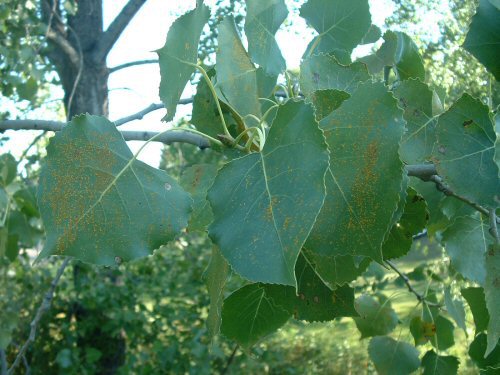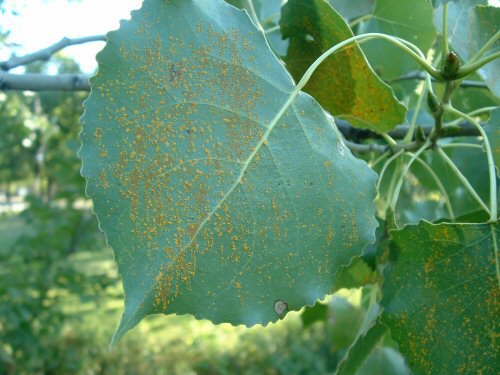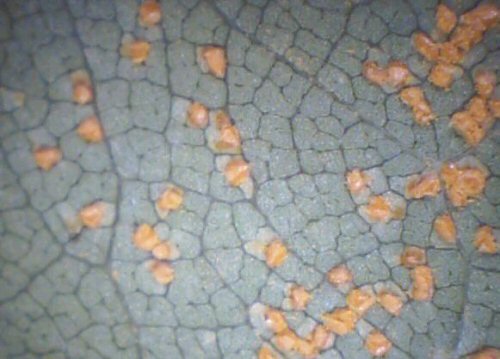Poplar Rust
In locations where there is intensive planting of poplar clones as ornamentals, shelterbelts, and agro wood-lot operations, leaf rust of poplar (caused by species of the fungus Melampsora, most notably Melampsora medusae and its sub-species) has the potential to be a severe problem. When symptoms are severe, early leaf senescence and subsequent defoliation, contribute to reduced vigour in the following year’s growing season. Early defoliation by rust can cause significant economic losses to plantings such as nurseries or woodlots which may have numerous young or newly planted trees, usually at high densities.
Outbreaks of rust can result in early defoliation, weakening of trees, and the potential reduction of the available carbohydrate in the tree. Increased winter damage could result in a slow decline in more established trees such as those in ornamental and shelterbelt plantings. Over the course of several consecutive years, severe poplar rust can reduce fibre yield and predispose the trees to colonization by a number of opportunistic pathogens, most notably to species of Cytospora, a common canker (see Figure 2) problem of poplars.
Signs and Symptoms of Poplar Rust
Initially, on susceptible poplars, small, yellow spots appear on the upper leaf surface. On the lower leaf surface, pale yellow to orange powdery uredia (which contain the tiny spores that can reinfect poplar) will be present (see Figures 1,3, 4, and 5) As the season progresses, the diseased leaves turn to a crust-like orange-brown appearance which is the overwintering stage of the rust, that permits survival on fallen leaves. The fungus has a secondary host on larch/tamarack (Larix laricina).
In areas where the disease is a common occurrence, the disease severity on the poplar leaves may produce disfigured leaves triggering leaves to fall from the tree. The more susceptible a tree is to leaf rust, the sooner the loss of leaves begins.
As poplars tend to grow quite rapidly, a loss of vigour is difficult to recognize in practice. Comparisons to nearby healthy trees could be made, though growth rates of different species/hybrids can vary with location.
Spores produced in spring from these overwintering stages on fallen leaves can infect nearby larch trees in the early spring, if present. Later in the season, spores produced on infected larch branches reinfect poplars. Larches/Tamarack are not common in Manitoba and early spring infections of poplar don’t likely occur here. Most infections would be late summer to early autumn infections derived from long distance travel of wind-borne spores.
Yield losses of more than 30% to 50%, in volume and dry weight of poplar wood have been reported. On the larch (Larix laricina) host little economically significant damage occurs.
Conditions for Development
The wet, humid conditions, which have promoted long moisture periods on leaf surfaces in Manitoba over the past few weeks have been ideal for rust development. Humid conditions with temperatures of 15°C to 20°C, are ideal for production of urediniospores on the Populus host.
Management
Removal of fallen leaves will not control rust as the infectious spores are wind-borne, often from great distances.
- Increase tree vigour through proper watering, fertilizing, and mulching
- In ornamental plantings of poplars, where leaf rusts are a problem, collect and compost or burn the fallen leaves to destroy infective spores. This method is only useful if the rust fungus has survived in the orange uredial state (in which the spores can initiate disease in poplar), which would not be a common occurrence in Manitoba. Long distance movement of spores would still present a risk. Should the fungus overwinter as telia (much more likely in a 'normal' Manitoba winter) the spores released will need to infect larch, and cannot infect the poplar.
- If rust resistant Populus adapted to local conditions are available they may be worth considering. They limit colonization by rust fungi and thus limit or prevent spore production and disease buildup.
- In areas where continuous and heavy infection occurs, new plantings of poplars should be located as far away from susceptible conifers as possible.
- Poplar rust fungi can develop many pathogenic races. Planting mixtures of poplar clones that differ in resistance to various rust strains can delay the buildup of rust and result in less severe rust and higher yields than occur in monoclonal plantations. Clones that are highly susceptible to poplar rust, should not be propagated.
Table 1: Poplars (Populus spp.) in Manitoba (introduced and native) known to be susceptible to Melampsora medusae, the cause of poplar rust.
| Populus alba | White Poplar |
| Populus alba var. nivea | Silver Poplar |
| Populus balsamifera | Balsam Poplar |
| Populus canescens | Gray Poplar |
| Populus deltoides | Eastern Cottonwood |
| Populus grandidentata | Large-Toothed aspen |
| Populus nigra | Black Poplar |
| Populus nigra var. italica | Lombardy Poplar |
| Populus tremuloides | Trembling Aspen |

Figure1: Symptoms of poplar rust on the leaves of an eastern cottonwood (Populus deltoides)

Figure 2: Stressed poplar tree with oozing canker. (This is not attributed to rust infection, but trees severely impacted with rust can be weakened, allowing opportunistic pathogens to colonize)

Figure 3: Uredia (spore masses) of poplar rust on the lower surface of an eastern cottonwood (Populus deltoides)

Figure 4: Poplar rust uredia (containing urediospores) on underside of eastern cottonwood (Populus deltoides)

Figure 5: Masses of poplar rust urediospores being released from uredia on underside of eastern cottonwood (Populus deltoides)

